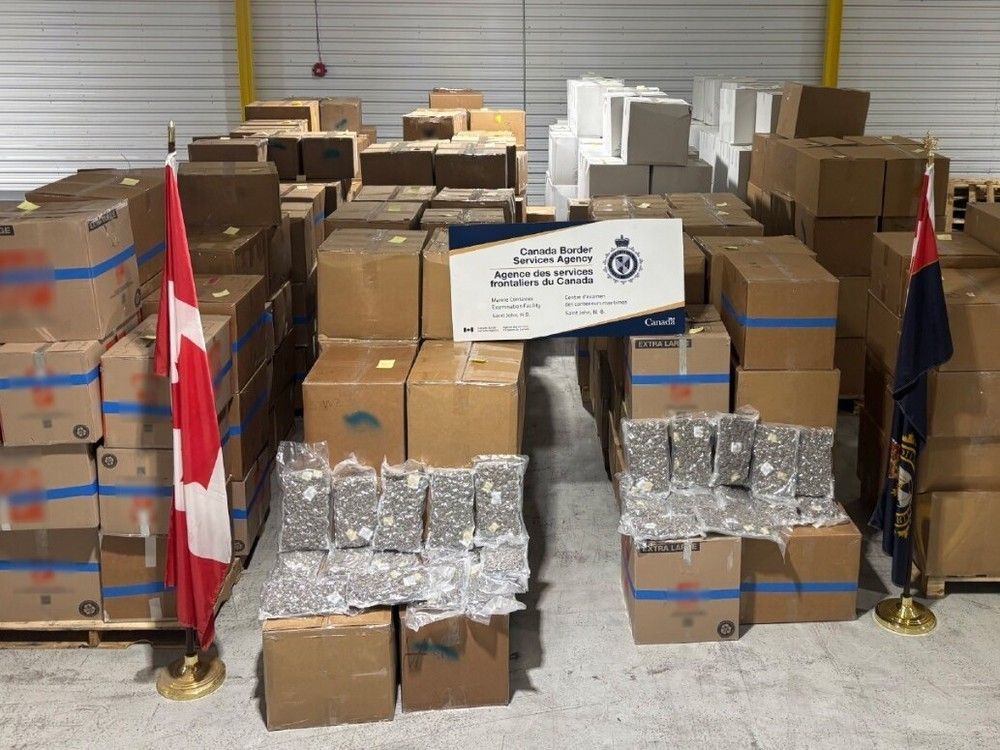
With an estimated value of $49.6 million, a recent seizure of cannabis in Saint John by Canada Border Services Agency (CBSA) officers is being called the largest seizure on record in the past 10 years.
In a media release, CBSA report border services officers at the Port of Saint John received assistance from CBSA intelligence officers in the Greater Toronto Area and Atlantic Regions and examined a marine container on May 21 destined for export to Scotland, United Kingdom.
“During this examination, officers uncovered over 6,700 kilograms of suspected cannabis, valued at $49.6 M,” stated the media release. “The drugs were falsely declared on the documentation provided to the CBSA and were concealed in nearly 400 boxes inside the container.”
CBSA stated the quantity of drugs seized in this shipment is three times more than the total amount of cannabis seized by the CBSA across Canada in the previous year. Statistics on the CBSA website show in 2024 there were 1,716.4 kilograms of cannabis products seized.
Megan Cliffe, chief of container and commercial operations in Saint John for CBSA, told Brunswick News the seizure is “monumental” and, in her 20 years in the field, she has never seen a seizure of this size.
While Cliffe said she was limited in what she could disclose regarding the seizure due to the fact it remains an ongoing investigation with the RCMP, she did note the cannabis was being transported to Saint John via rail.
“This was an export interception that we picked up that was coming on rail to go on to a marine vessel,” she said. “I really can’t speak to too much outside of that. What led up to that there’s not a lot I can share. We’re a small piece. Our role here at the marine container exam facility, where we actually examine, we get the referral and we conduct the exams and luckily, this time, it was a positive examination for the suspected cannabis.”
Cliffe explained the examination of containers at Port of Saint John involves a methodology where each one is screened and various tools are used to determine which ones will be selected for examination based on the level of risk and then border officers will determine what level of exam will be conducted. She said approaches to examination can range from unloading them to using X-ray imaging equipment to on-pier examinations with the containers being opened.
Speaking to this particular seizure, Dominic Mallette, regional director for CBSA Atlantic Region, stated he was “extremely proud” of the skill, professionalism and work by all involved.
“This historic seizure is the result of a unified tactical plan and effective information-sharing among CBSA officers and our law enforcement partners,” Mallette stated in the release.
The cannabis and all evidence were transferred to the Royal Canadian Mounted Police (RCMP) Eastern Region Federal Policing (New Brunswick) for further investigation with RCMP Superintendent Germain Leger noting the force works closely with provincial, national, and international law enforcement partners, including agencies such as CBSA for a “coordinated response to reduce the flow of illicit drugs within and outside of Canada. Intelligence sharing and operational engagement with our partners contributes to successful action against the illegal drug trade.”
Cliffe said seizures of any type by CBSA are vital in terms of the agency’s role in Canada’s security.
“It is very important. Our role here with CBSA is to protect the safety and security of Canadians and this is a huge step in that process and combatting organized crime,” she said. “This was a monumental seizure and I’m extremely proud of the team and the work that went into this success.”
CBSA explained further that although cannabis is legal in Canada, cannabis smuggling supports organized crime and funds illegal activities, such as narcotics and weapons smuggling noting in the release it “is often used as an exchange for other illegal drugs being imported into Canada such as cocaine.”